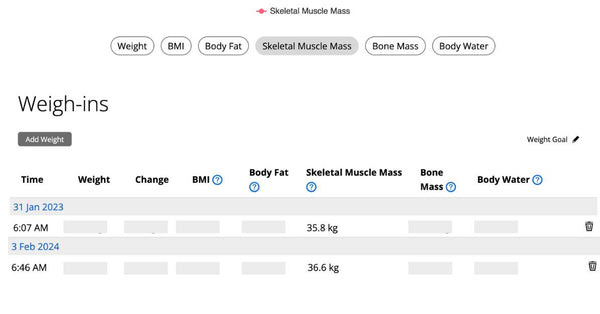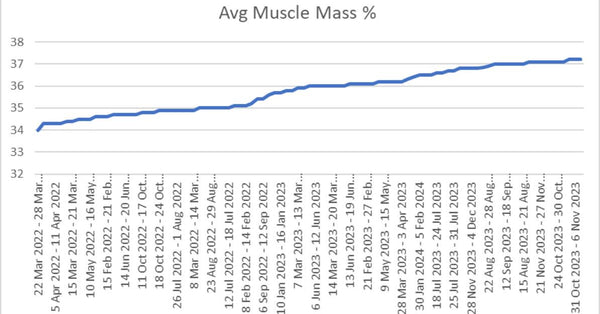Old age = less muscle = reduced capability. Or does it?
Sarcopenia is the loss of muscle mass due to age. We also often slow down as we get older. Muscle mass = age x usage x nutrition.
Can you build muscle mass after 50?
Yes. Short answer. But it doesn't happen naturally, as Captain Obvious would say. Read more.
Why do you lose muscle?
Muscle tissue changes as you age. It decreases on average 3-8% per decade after the age of 30 and accelerates after 60 years of age. This is a fundamental cause and contributor to disability in order people.
Did you know falls in Australians over 65 years old are the most common injury, and are 77% of hospitalisations? Why? If you don't keep physically active, you tend to have poorer balance, and weaker muscles, and guess what, you might fall a lot as a result.
Do the maths. If you have say theoretically 35 KG of muscle when you're 30, and you lose an average of say 5.5% (average of range 3-8%) per year, then:
40 years old - lost 1.9 KG leaving 33 KG of muscle.
50 years old - lost 1.81 KG leaving 31.1 KG of muscle.
60 years old - lost 1.71 KG leaving 29.4 KG of muscle.
Total loss of 5.42 KG or 15.5%, and it accelerates after 60.
Ever seen anyone look smaller at 50 than they did at 30? Well, it's apparently not muscle. Those joints and organs are working harder with less muscle support.
So, fight every inch on this to retain and gain as much muscle as possible.
I get it, careers, kids, holidays, etc. But the kids grow up, you get on top of your career and just you and your muscle are left. If you know what I mean.
How mobile and capable physically do you want to be at say 65 years old? Not only that, but exercise is also great for mental health. Building muscle after 50 is worth it. Building muscle is not just reserved for the younger generation.
I gained muscle mass.
I gained through a protein supplement and resistance training. It wasn't that hard or that organised now that I think about it. Just get into a routine.
Below you can see my muscle mass over the last 12 months. I didn't set out to do this, I was hoping just to maintain my muscle mass. But I did know that if you don't use muscles, you lose them,
These data points are from a Garmin Index scale at a similar time every morning. Not you can argue the accuracy of such a scale, I would argue whatever the accuracy, as long as it's consistent. The stats were then downloaded from Garmin Connect, (I decided to keep my weight private)
As close as I could get to 12 months apart, nearly 1 KG was added in muscle. The lowest muscle mass during this period was 34 KG in March 2022 (I downloaded 2 years of data) and the highest 37.3 KG in September 23, a range of 3.3 KG.

I know the above gains might not break any records, but I was just happy that my muscle mass improved rather than the other way around. Here is what it looked like over time.

How does this work?
Muscle quality has been shown to improve significantly with resistance training in older people. Resistance and aerobic exercise are both useful to counteract Sarcopenia, and the associated metabolic alterations of the muscle.
Malnutrition is the other factor. Just not the way you know it.
As we reduce food intake, so we reduce protein intake.
This is often to comply with reduced fat diets, while our protein requirements may in fact be higher. Amino acids from ingested protein can directly stimulate muscle protein synthesis, similar to our younger counterparts.
Increases in muscle mass were associated with resistance training, but not necessarily an increase in protein in diet. This was because of the presence of carbohydrates which can impair the anabolic response of the muscle.
Supplements should only contain what is necessary to support muscle protein anabolism. You can read the research here.
Having only essential amino acids or protein can be beneficial to promoting muscle growth.
The next step is how much? I will leave that to you and our protein intake chart. When you do the maths, you will probably work out you may be short on a daily basis. I was. Listen to our podcast on protein below for more info.
What helped?
(1) I used the Old Bull Health Fitter Stronger Pack, a daily mix of protein powder, and our Testosterone & Immunity Formula. I used it first thing every morning, and I might have missed breakfast.
Protein can suppress ghrelin, the hunger hormone, so appetite is in check at least until lunchtime. Ghrelin can have a significant impact on appetite.
Ghrelin is produced in the gut and travels to the brain to tell you to find food. The more ghrelin, the hungrier you are. The more you diet, the higher the ghrelin. Read more on the effects of protein on appetite, satiety, and food cravings on PubMed.
(2) I followed our TTGR program, (listen below) which is 3 sets of 14 resistance-based exercises, 45 seconds on and 15 seconds off, over 42 minutes. On average 2-3 times per week.
I also used Old Bull Protein either before, during, or just after this exercise.
This gave me around 55 g of protein a day from a supplement, and then fish, chicken, eggs, and/ or milk would give me another 30-40 g which brought my total protein intake close to my target of 1 - 1.2 g of protein per KG of body weight per day. Official guidance starts at 0.84g/KG weight for a male over 19 years old and 75 KG, exercise unclear.
(3) Supplements can be controversial, and there are many that contribute to muscle quality and mass. You could of course just eat a balanced diet.
What I focussed on was Vitamin D3, deficiency can be common in older men, keep this to a sensible dose. Ashwagandha, and Zinc which can contribute to building and repairing muscle.
(4) Testosterone. Do all you can to boost this naturally.
(5) Electrolytes. We do a detailed comparison here including prices on LVELUP, Hydralyte, LMNT and more. Check out the electrolyte comparison here.
Next steps
- Change your mindset. You can and should build muscle mass. Do resistance training, not just aerobic exercise.
- Increase or get your protein intake right.
- Ensure your vitamin D intake is adequate.
- Get to a healthy body weight for your age and height.
- Try boosting your testosterone, naturally.
My plan is to be a little more rigid on the weigh-ins, protein, and diet over the next 3 months as well as consistently do TTGR 3 times a week and then reassess physiological changes. Watch this space, and now go build some muscle.

